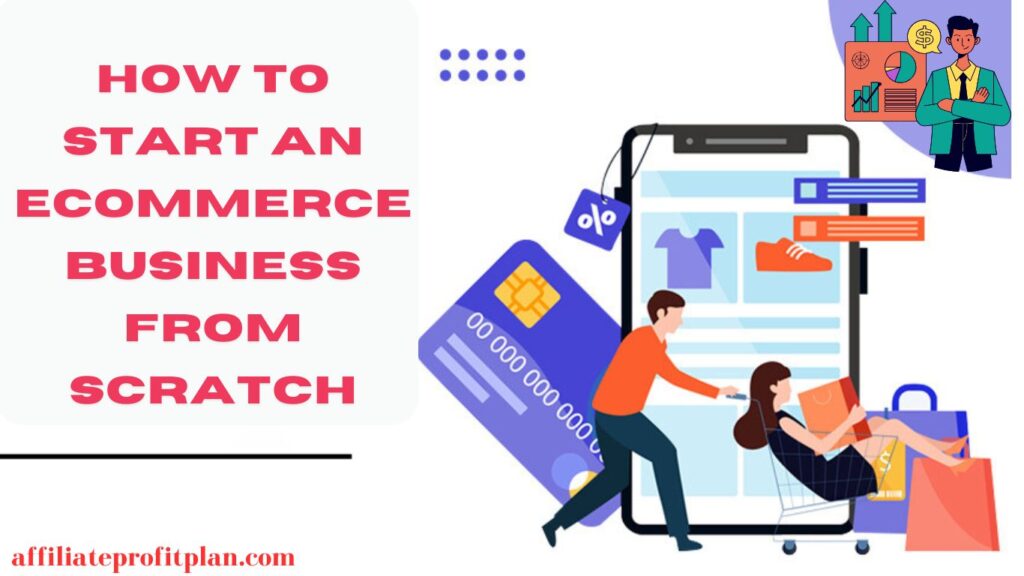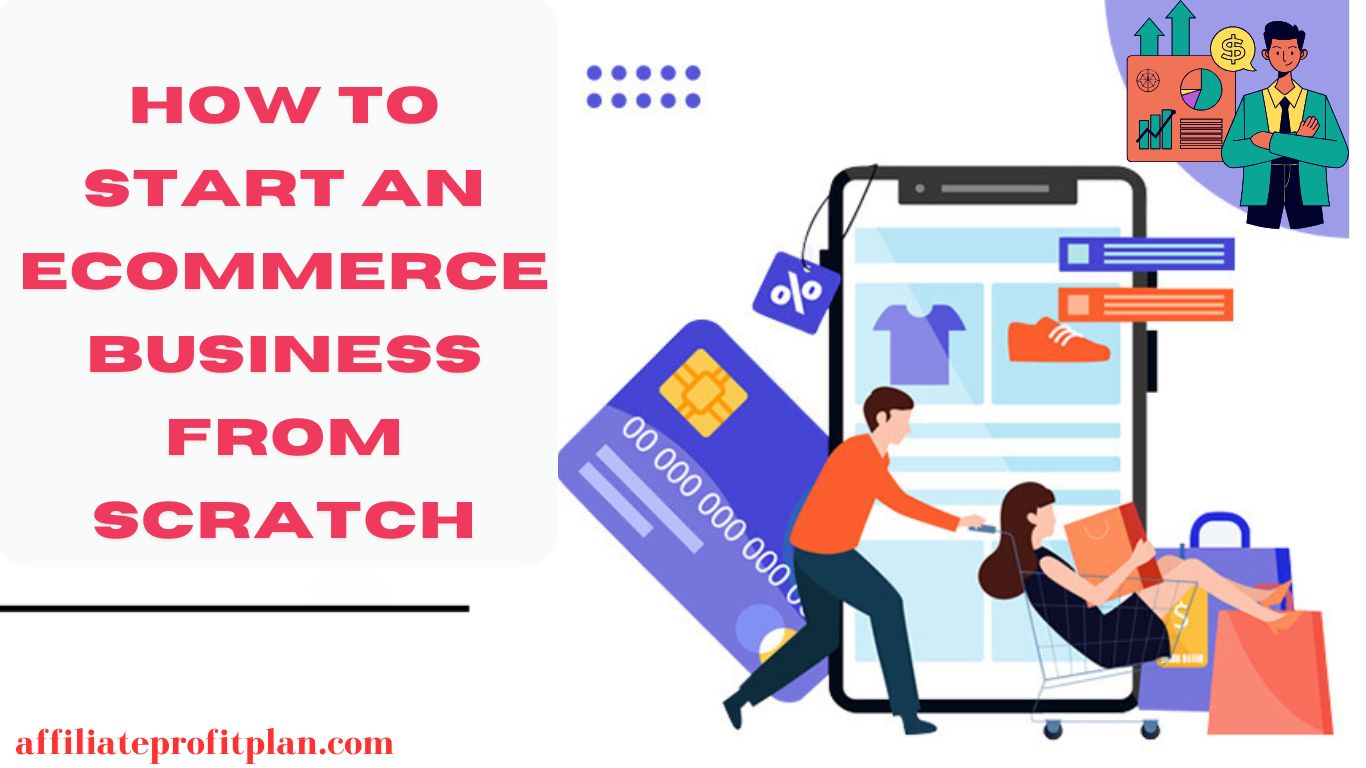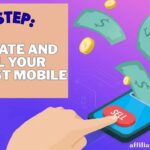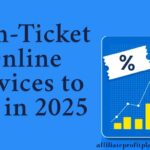Welcome to my article How to Start an eCommerce Business from Scratch. So, you want to start an eCommerce business? Great choice! After all, who wouldn’t love the idea of making money while wearing pajamas and sipping coffee? But before you start picturing stacks of cash rolling in overnight, let’s be real—building a successful online store isn’t just about picking a trendy product and watching sales explode. It takes strategy, research, and a little bit of patience (okay, maybe a lot).
The good news? Starting an eCommerce business today is easier than ever. With the right niche, a well-designed online store, and a solid marketing plan, you can turn a simple idea into a profitable venture. Whether you’re looking to sell handmade crafts, trending gadgets, or even start a dropshipping empire, this guide will walk you through the process step by step. From choosing the perfect product to driving traffic and making those first sales, we’ll cover everything you need to know—without the fluff. So, grab your coffee (or energy drink) and let’s get started!
Access My Proven Blueprint for $50-$100 Daily Income – Watch This FREE Video Now >>>

Finding the Right Niche and Products to Sell
Before you start daydreaming about six-figure sales and early retirement, let’s talk about the foundation of every successful eCommerce business—choosing the right niche. Picking a random product and hoping for the best is like throwing spaghetti at the wall and praying it sticks (spoiler: it won’t). The key is to find a niche that’s profitable, in demand, and something you won’t get bored of in two weeks.
How to Choose a Profitable Niche
A good niche strikes the perfect balance between passion and profit. Sure, you might love collecting antique spoons, but if no one else does, your business won’t go far. Here’s how to narrow it down:
- Check Market Demand – Use Google Trends, Amazon Best Sellers, and social media to see what’s trending. If nobody is searching for it, it’s probably not worth selling.
- Look at Competition – A little competition is healthy—it proves there’s demand. But if the market is saturated with big brands, you might want to niche down further.
- Solve a Problem – The best products make life easier. Think about pain points people have and how your product can help.
- Consider Profit Margins – Selling cheap items means you’ll need to move massive volume to make a decent profit. High-ticket products or recurring purchases (like subscriptions) can be a better bet.
Different Business Models to Consider
Once you have a niche, you need to decide how you’ll source and sell your products:
- Dropshipping – No inventory, no shipping hassles. Just list products, take orders, and let a supplier handle the rest. Sounds like a dream, right? Well, profit margins can be thin, and quality control is tricky.
- Print-on-Demand – Great for selling custom designs on t-shirts, mugs, and more. Perfect if you want to be creative without worrying about inventory.
- Private Label & White Label – Create your own brand using pre-made or slightly modified products. More control, but higher upfront costs.
- Handmade & Custom Products – If you have a talent for making things (jewelry, art, candles), this could be your sweet spot. Just be ready for the time investment.
Common Mistakes to Avoid
- Picking a niche just because it’s trending – Fidget spinners, anyone? Trends come and go, so aim for something with long-term demand.
- Ignoring your target audience – Selling baby products? Your audience isn’t teenagers on TikTok. Know who you’re marketing to.
- Choosing a product with razor-thin margins – If you’re making $1 per sale, you’ll need a whole lot of sales to make a profit.
Finding the right niche takes research, patience, and a little trial and error—but once you nail it, everything else (marketing, branding, sales) becomes so much easier. Ready to move to the next step? Let’s talk about setting up your store!
Setting Up Your Online Store: Choosing the Right Platform
Alright, you’ve picked your niche, found the perfect product, and you’re feeling like the next eCommerce mogul. Now comes the fun part—building your online store! But before you start designing a flashy website with glittery fonts (please don’t), you need to choose the right platform to bring your store to life. Think of it like picking a home for your business—choose wisely, or you’ll be stuck dealing with endless headaches and hidden fees.
Popular eCommerce Platforms: Which One is Right for You?
There are plenty of eCommerce platforms out there, but let’s break down the most popular options:
- Shopify – The go-to for most new eCommerce entrepreneurs. It’s easy to use, has tons of built-in tools, and lets you launch a store in minutes (seriously). The downside? Monthly fees and transaction costs can add up.
- WooCommerce (WordPress) – Perfect if you love customization and don’t mind a little tech work. It’s free, but you’ll need hosting, themes, and plugins—which can get pricey.
- BigCommerce – Great for scaling businesses. It offers built-in SEO and marketing tools, but it’s slightly more complex than Shopify.
- Wix eCommerce – Super beginner-friendly and great for small stores. But if you plan on growing fast, it might feel limiting.
- Magento (Adobe Commerce) – For the pros. If you have coding skills (or a developer on speed dial), Magento gives you total control—but it’s not beginner-friendly.
Key Factors to Consider When Choosing a Platform
Before you commit, ask yourself:
✅ How easy is it to use? – If it requires a PhD in coding, you might want to look elsewhere.
✅ What’s my budget? – Some platforms have monthly fees, transaction fees, and extra costs for apps and themes.
✅ Do I need integrations? – If you’re using email marketing, dropshipping, or social media selling, make sure your platform supports it.
✅ Can it scale? – Your tiny store today might be a six-figure brand tomorrow. Pick a platform that can grow with you.
Setting Up Your Store Like a Pro
Once you’ve chosen a platform, it’s time to get your store up and running:
- Get a Domain Name – Yourstore.com sounds way better than Yourstore.shopify.com. A custom domain makes you look legit.
- Pick a Theme – Keep it clean, modern, and mobile-friendly. No one likes a cluttered website.
- Add Essential Pages – Home, About, Contact, FAQ, and Policies (trust me, customers check these).
- Optimize for Mobile – More than 60% of shoppers use their phones—make sure your store looks amazing on all devices.
- Set Up Payment Methods – Shopify Payments, PayPal, Stripe, or even Buy Now, Pay Later options to boost conversions.
Final Thoughts
Choosing the right platform is one of the biggest decisions for your eCommerce success. Don’t rush it—compare options, test free trials, and pick the one that fits your business now and in the future. Once your store is set up, it’s time to fill it with amazing products and start making sales!
Ready for the next step? Let’s talk about creating high-converting product listings!
Creating a High-Converting Product Listing
You’ve got your store set up—congrats! 🎉 But before you sit back and wait for the sales to roll in, let’s talk about something crucial: your product listings. Because here’s the deal—even the best product in the world won’t sell if your listing is boring, confusing, or just plain bad. Your product page needs to grab attention, build trust, and convince customers to hit that “Buy Now” button faster than they can say “take my money!”
Access My Proven Blueprint for $50-$100 Daily Income – Watch This FREE Video Now >>>
The Secret Sauce to a Winning Product Listing
A high-converting product page isn’t just about slapping up a few images and a price tag. It needs to tell a story, highlight benefits, and remove doubts. Here’s how to make your listings irresistible:
1. Write a Compelling Product Title
Your product title should be clear, descriptive, and keyword-rich. Think of it as a mini sales pitch. If you’re selling a portable blender, don’t just write “Portable Blender”—that’s boring. Instead, try something like:
🔥 “PowerBlend Pro | Rechargeable Portable Blender – Smoothies On the Go!”
This tells customers exactly what they’re getting and makes it sound exciting.
2. Create an Engaging Product Description
Your description should do two things:
✔ Explain what the product does
✔ Make the customer feel like they need it in their life
Instead of writing:
❌ “This is a 16oz portable blender with a rechargeable battery.”
Try this:
✅ “Tired of clunky, noisy blenders? The PowerBlend Pro lets you whip up fresh smoothies anytime, anywhere—no outlets needed! With a powerful rechargeable battery and sleek design, it’s your perfect travel companion.”
Pro Tip: Focus on benefits, not just features. Customers don’t just want to know what it is—they want to know how it will make their life better.
3. Use High-Quality Images (and Videos!)
Would you buy something online without seeing it first? Neither would your customers.
- Use multiple high-quality images that show the product from different angles.
- Lifestyle photos (showing the product in action) make it easier for customers to imagine using it.
- Videos boost conversions by up to 80%—consider adding a short demo!
4. Highlight Key Features with Bullet Points
Most shoppers scan, not read, so break down the key selling points with easy-to-digest bullet points:
✔ Powerful 300-watt motor for smooth blending
✔ USB rechargeable – lasts up to 15 blends per charge
✔ Compact & lightweight – fits in your bag for on-the-go use
✔ Easy to clean – self-cleaning function with just water & soap
This makes it quick and easy for shoppers to see why your product is awesome.
5. Add Social Proof & Reviews
People trust other people—not just your sales pitch. A product with positive reviews is WAY more likely to convert.
- Showcase customer reviews (with photos if possible!)
- If you’re just starting out and don’t have reviews yet, consider adding a testimonial section with influencer quotes or early tester feedback.
- Use trust badges (like “100% Money-Back Guarantee” or “Secure Checkout”) to ease buying hesitation.
6. Create Urgency & Scarcity (Without Being Pushy)
Ever notice how Amazon listings say “Only 3 left in stock” or “Limited-time deal”? That’s because urgency works.
You can do the same by adding:
🔥 “Limited Stock Available – Order Now Before It’s Gone!”
⏳ “Flash Sale: Get 20% Off – Today Only!”
This helps push customers to buy now instead of “thinking about it” and never coming back.
Final Thoughts
A great product listing does more than just describe your product—it sells it. By using clear titles, benefit-driven descriptions, eye-catching images, and trust-building elements, you’ll turn casual browsers into buyers.
Next up? Let’s drive traffic to your store and get those sales rolling in!
Driving Traffic to Your eCommerce Store
So, your online store is up and running, your product listings are looking top-notch, and now you’re just sitting there, refreshing your sales dashboard, wondering when the money will start rolling in. But crickets. 🦗
Here’s the truth: even the most beautiful store with the best products won’t make a dime if no one knows it exists. Traffic is the lifeblood of your eCommerce business, and if you want to start making sales, you need to get people through the virtual door. Let’s talk about the best strategies to drive traffic (and customers) to your store—without just hoping for the best.
1. Master the Art of SEO (Search Engine Optimization)
Want free, long-term traffic? SEO is your best friend. By optimizing your store for search engines, you can rank higher on Google and attract shoppers who are already looking for your products.
Here’s how to do it:
✅ Use the right keywords – Find what people are searching for and add those keywords to your product titles, descriptions, and meta tags.
✅ Optimize your images – Name your images properly (e.g., “portable-blender-smoothies.jpg” instead of “IMG1234.jpg”) and use alt text to help Google understand them.
✅ Write helpful blog content – A blog can drive tons of organic traffic by answering common questions related to your niche. (Example: “Best Smoothie Recipes for Weight Loss” if you sell blenders).
✅ Speed up your website – Slow websites lose customers faster than a bad WiFi connection. Optimize loading times to keep visitors engaged.
🚀 Pro Tip: SEO takes time, but once your store ranks, you’ll get consistent, free traffic without paying for ads!
2. Leverage Social Media Marketing
If your store isn’t on social media, you’re missing out on billions of potential customers. The key is choosing the right platform for your audience.
- Instagram & TikTok – Perfect for visually appealing products like fashion, beauty, and home decor. Use reels, influencers, and user-generated content.
- Facebook – Great for running ads, selling through Marketplace, and engaging with niche groups.
- Pinterest – A hidden gem for eCommerce. People use it to discover and buy products! Create eye-catching pins linking back to your store.
- YouTube – Create product demos, tutorials, or unboxing videos to showcase your items.
Engagement matters! Don’t just post and disappear—reply to comments, DMs, and build relationships with your audience.
🚀 Pro Tip: Run giveaways and contests to boost engagement and get more eyes on your products!
3. Run Paid Ads (The Fast-Track to Sales)
If you want immediate traffic, paid ads are the way to go. But don’t just throw money at Facebook and hope for the best—be strategic.
Best Ad Platforms for eCommerce:
💰 Facebook & Instagram Ads – Highly targeted and great for retargeting visitors who didn’t buy the first time.
💰 Google Shopping Ads – Perfect for getting your products in front of high-intent buyers searching for them.
💰 TikTok Ads – If your audience is young and loves video content, TikTok ads can generate huge sales fast.
Start small, test different ads, and scale up what works. Don’t blow your budget on ads that don’t convert!
🚀 Pro Tip: Use retargeting ads to bring back visitors who abandoned their carts (you’d be surprised how many people forget to check out!).
4. Build an Email List & Use Email Marketing
You know what’s better than one-time buyers? Repeat customers. And email marketing is one of the best ways to keep people coming back.
Ways to Grow Your Email List:
📩 Offer a discount (like “Get 10% Off Your First Order!”) in exchange for their email.
📩 Use a pop-up (but make it fun, not annoying).
📩 Add an exit-intent offer—when someone’s about to leave, show a last-minute deal!
Once you have an email list, send valuable content (not just sales pitches).
💌 Welcome emails – Introduce your brand and offer a special deal.
💌 Abandoned cart emails – Remind shoppers to complete their purchase (with a discount if needed).
💌 Exclusive offers – Reward your subscribers with early access to sales.
🚀 Pro Tip: Email marketing has an ROI of 4,200%—so if you’re not using it, you’re leaving money on the table!
5. Collaborate with Influencers & Brand Ambassadors
Influencer marketing isn’t just for big brands. Even small businesses can benefit from influencers and micro-influencers (people with smaller but highly engaged audiences).
How to do it:
🤝 Find influencers in your niche – Look for ones with authentic engagement (not just followers).
🤝 Send them free products in exchange for a review or social media post.
🤝 Create an affiliate program – Give influencers a commission for every sale they drive.
🚀 Pro Tip: Micro-influencers (5k-50k followers) often have higher engagement than big influencers—and they charge way less!
Final Thoughts
Driving traffic to your eCommerce store takes a mix of strategies—you can’t just rely on one method.
💡 SEO gets you free, long-term traffic.
💡 Social media & influencers get people talking about your brand.
💡 Paid ads give you instant visibility.
💡 Email marketing keeps customers coming back for more.
With the right approach, you won’t just get traffic—you’ll get converting traffic. And that’s the secret to making real sales.
Next up? Let’s talk about retaining customers and turning them into loyal fans!
Managing Orders, Shipping, and Customer Support: Keeping Your eCommerce Machine Running Smoothly
So, you’ve got traffic, customers are clicking “Add to Cart,” and the sweet sound of “cha-ching!” notifications is music to your ears. But hold on—before you start celebrating like you just won the lottery, there’s one major thing to handle: fulfilling those orders and keeping customers happy.
eCommerce isn’t just about selling—it’s also about delivering on your promises. And that means managing orders efficiently, shipping them on time, and offering top-tier customer support. Because let’s face it—a happy customer is a repeat customer, and a repeat customer is basically free money.
1. Streamlining Order Management
Once a customer hits that “Buy Now” button, the clock starts ticking. You need to process orders quickly and accurately to avoid delays, mix-ups, and unhappy customers.
How to Keep Your Order Management on Point:
🛒 Use an automated system – Platforms like Shopify, WooCommerce, or BigCommerce have built-in order management features that track orders, process payments, and sync inventory automatically.
🛒 Keep your inventory updated – The last thing you want is to sell a product that’s out of stock (nothing screams “bad experience” like canceling an order because you miscounted inventory).
🛒 Set up order notifications – Automate emails/SMS updates so customers know when their order is confirmed, shipped, and delivered (because nobody likes being left in the dark).
🚀 Pro Tip: If you’re scaling fast, consider an Order Management System (OMS) like ShipStation, Ordoro, or TradeGecko to keep things organized and avoid chaos.
2. Choosing the Right Shipping Strategy
Shipping can make or break an eCommerce business. Offer slow or expensive shipping, and customers will bounce faster than a bad WiFi connection. Offer fast and affordable shipping, and you’ll have shoppers coming back for more.
Shipping Options to Consider:
📦 Flat-rate shipping – A fixed fee for shipping, easy to understand for customers.
📦 Free shipping – Everyone loves free stuff! Build shipping costs into your product prices.
📦 Real-time carrier rates – Calculate shipping costs based on the customer’s location (used by Amazon and big retailers).
📦 Expedited shipping – Some people will pay extra to get their order ASAP. Give them the option!
Which shipping carrier should you use?
🚛 USPS, FedEx, UPS, DHL – Good for domestic and international shipping.
🚛 Third-party fulfillment centers (3PLs) – If you don’t want to pack and ship orders yourself, use services like ShipBob or Amazon FBA to handle it for you.
🚀 Pro Tip: Offer free shipping for orders over a certain amount to increase your average order value (AOV). For example, “Spend $50 and get FREE shipping!”
3. Handling Returns & Refunds Like a Pro
Let’s be real—returns are part of the game. How you handle them can turn a one-time buyer into a lifelong customer.
How to Make Returns Hassle-Free:
🔄 Have a clear return policy – Put it on your website so customers know what to expect before buying.
🔄 Make the process easy – Offer prepaid return labels or let customers generate one themselves.
🔄 Be fair but firm – Avoid overly strict return policies (like “no returns after 3 days”—yikes). A flexible return policy can actually boost sales because it makes customers feel more confident buying from you.
🔄 Handle refunds fast – Nobody wants to wait weeks to get their money back. Issue refunds quickly to keep trust levels high.
🚀 Pro Tip: If a product is low-cost, consider offering a replacement instead of a return (it’s sometimes cheaper than handling return shipping).
4. Providing Outstanding Customer Support
Want to stand out from the competition? Offer amazing customer service. A single bad experience can turn a potential loyal customer into a bad review on Yelp, Trustpilot, or social media.
Here’s how to win at customer support:
💬 Live chat support – Customers LOVE getting quick answers. Install a chatbot or have a real person available to help.
📧 Fast email response times – Reply to inquiries within 24 hours (or even faster if possible).
📞 Offer phone support (if feasible) – Some people prefer talking to a human. If you can, have a support number available.
📱 Use social media – Customers often reach out via Instagram, Facebook, or Twitter. Stay active and respond promptly.
🚀 Pro Tip: Use a Helpdesk tool like Zendesk, Gorgias, or Freshdesk to manage customer queries more efficiently.
5. Turning Customers into Repeat Buyers
It’s 5X cheaper to retain a customer than to acquire a new one. So once someone buys from you, don’t let them forget you!
Here’s how to keep customers coming back for more:
🔄 Send follow-up emails – A “Thank You” email + a discount on their next purchase works wonders.
🔄 Start a loyalty program – Reward repeat buyers with points, discounts, or free products.
🔄 Ask for reviews & testimonials – Happy customers will help you attract new ones.
🔄 Engage on social media – Keep customers involved with your brand even after their purchase.
🚀 Pro Tip: Offer exclusive deals to past customers to make them feel valued and special. (Example: “Hey [Name], here’s a VIP 20% off coupon just for being awesome!”)
Final Thoughts
Running an eCommerce business isn’t just about making sales—it’s about keeping customers happy from checkout to delivery (and beyond).
💡 A smooth order management process keeps things running efficiently.
💡 Fast & reliable shipping makes customers more likely to buy again.
💡 Easy returns & great support build trust and loyalty.
💡 Repeat customers = more revenue with less effort.
Master these, and your eCommerce store won’t just survive—it’ll thrive.
Conclusion: Wrapping It All Up (With a Nice Digital Bow )
So, here we are—the finish line. If you’ve made it this far, congratulations! You now have a solid roadmap for starting your eCommerce business from scratch. From finding the perfect niche and setting up your online store to driving traffic and keeping customers happy, you’ve got all the tools to launch, grow, and scale your digital empire.
Access My Proven Blueprint for $50-$100 Daily Income – Watch This FREE Video Now >>>
But let’s be real—eCommerce isn’t a “get rich quick” scheme. It takes time, effort, and a whole lot of trial and error. (And possibly a few late-night existential crises when your first Facebook ad flops. Don’t worry, it happens to the best of us.) But the good news? Every successful eCommerce entrepreneur started exactly where you are now—at square one.
Your Next Steps? Take Action 🚀
Now that you have the knowledge, the only thing left to do is start. Seriously—don’t wait for the “perfect moment” (spoiler alert: it doesn’t exist). Whether it’s choosing a product, setting up your store, or testing your first marketing campaign, just take that first step.
Here’s a quick game plan:
✅ Pick a niche (Don’t overthink it—just start researching!)
✅ Set up your store (Choose a platform and get building!)
✅ List your products (Make sure those descriptions convert!)
✅ Drive traffic (SEO, ads, social media—get eyes on your store!)
✅ Deliver an amazing experience (Great service = repeat buyers!)
And remember: failure isn’t the opposite of success—it’s part of it. Learn from your mistakes, tweak your strategy, and keep pushing forward. Before you know it, you’ll go from “I hope this works” to “Wow, I just made my first sale!” and eventually, “I can’t believe I turned this into a full-time business!”
So, what are you waiting for? Your eCommerce journey starts NOW.
Thanks a lot for reading my article on “How to Start an eCommerce Business from Scratch” till the end. Hope you’ve helped. See you with another article.










